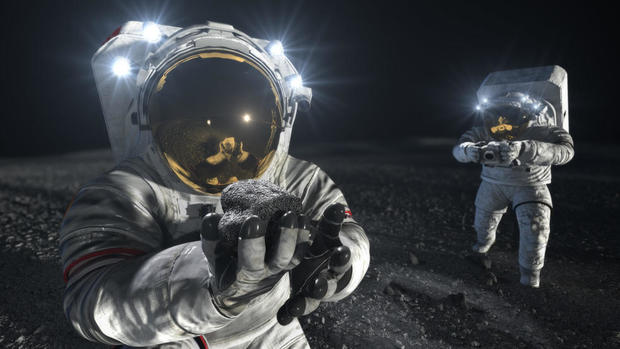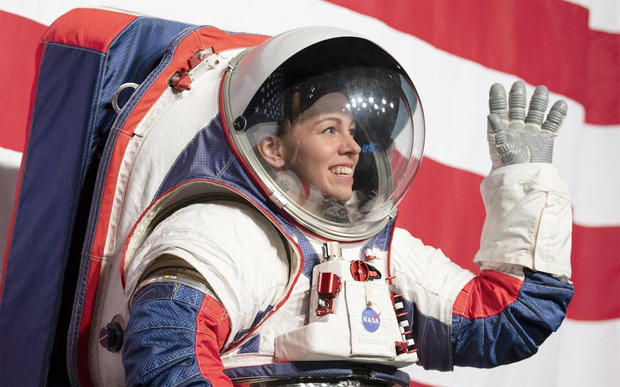NASA awards contracts to Axiom Space, Collins Aerospace for next-generation space and moon suits
Next-generation spacesuits, needed by astronauts aboard the International Space Station and by moonwalkers in NASA's Artemis program, will be provided by two companies competing for contracts valued at up to $3.5 billion through 2034, the agency announced Wednesday.
Houston-based Axiom Space and a team led by Collins Aerospace will develop suits that will be tested in a "relative environment" — in thermal vacuum chambers on Earth, in space, or just outside the ISS. The testing will take place in the 2025 timeframe, before the first planned Artemis moon landing.
NASA will evaluate the performance and select one or both suit designs for continued development and operational use.
"Theoretically, one company could win all of (the task orders)," said Lara Kearney, manager of the Extravehicular Activity and Human Surface Mobility Program at the Johnson Space Center. "So we will put the task orders out, we will compete them, we'll evaluate them. We have to also understand what our funding availability looks like."
She described the contract structure, with a maximum combined value of $3.5 billion, as "incredibly flexible."
"It's difficult to say today exactly how this contract is going to execute," Kearney said. "But that was on purpose and by design because we want the flexibility to be able to make those decisions as we see how these companies perform."
Officials declined to say how much each company will initially receive under the new contract.
NASA's current spacesuit, known as an extravehicular mobility unit, or EMU, is a decades-old design that has had problems as recently as March with potentially dangerous cooling water backups into an astronaut's helmet. Spacewalks currently are on hold pending resolution of the most recent incident.
NASA managers are confident engineers will identify the problem and implement a fix, and the suits are expected to remain in service aboard the ISS until a replacement is certified as safe for operational use.
The goal of the Exploration Extravehicular Activity Services, or xEVAS, contract is to replace the aging shuttle-era suits with one that would share life support and other systems with a version that could be worn by moonwalkers.
Both suits would feature state-of-the-art communications, computer technology and common life support systems with more robust reserves for emergencies. The lunar version would also feature enhanced mobility for walking about and bending down and back up in a gravity field on uneven surfaces.
Whether Axiom and Collins will develop a common suit design for both uses, or two substantially different designs, is up to the engineers.
"The requirements set for a low-Earth-orbit suit on space station and a suit on the lunar surface (are) not significantly different, particularly for the life support system," Kearney said.
"The differences really come in the pressure garment, the difference in being in zero gravity on space station versus having to walk on the moon, where you need all of the mobility," he added. "So really, at its core, the requirements set is generally the same. But we did not dictate to them that it'd be one suit, two suits or whatever."
Dan Burbank, a former astronaut and veteran spacewalker who now works with Collins Aerospace, said that in microgravity outside the space station, "you can be in the 350-pound suit and it's not an impediment. In fact, maybe by some estimations, it could actually be more stable platform to be in."
"But on a planetary environment, you've got trip hazards and a surface that is not amenable to ease of motion anyway," he explained. "So we would want to have a lower torso assembly that would have enough mobility for the crew member to walk naturally like they would on planet Earth."
Mike Suffredini, former manager of NASA's space station program and now CEO of Axiom Space, said the goal "is to make sure the suits are as similar as they can be."
"The other one that hasn't been mentioned is dust," he said. "Dust is a big deal on the moon, and that's one of the things you don't have to worry about in a microgravity environment. But it's a big, big problem on the surface."
Under the Artemis program, NASA plans to launch an initial unpiloted test flight later this year, sending an Orion crew capsule beyond the moon and back. A piloted test flight is expected in 2024, followed by the first landing near the south pole of the moon in mid to late 2025.
A new spacesuit has long been considered a pacing item in the Artemis timeline, and NASA began work to develop an advanced suit, known as the xEMU, several years ago. The agency eventually opted to turn the work over to private industry, putting out a request for information last year that led to Wednesday's contract award.
"There's a benefit to having two companies," Kearney said. "It provides us some redundancy as we go forward...It keeps competition in our system, which was also a goal."
for more features.


